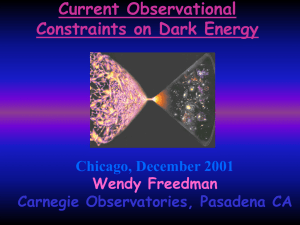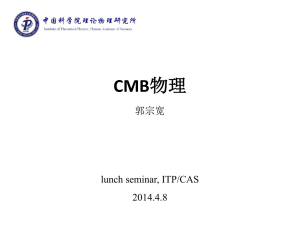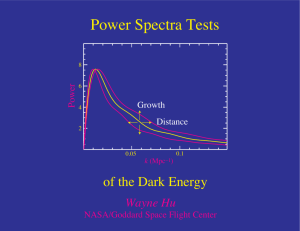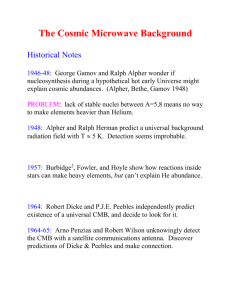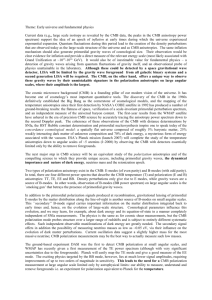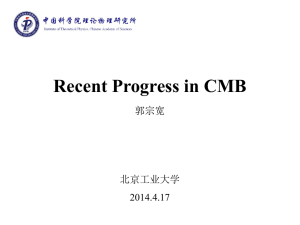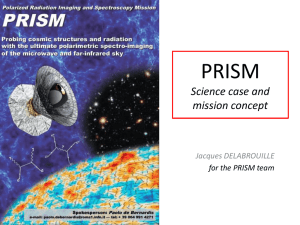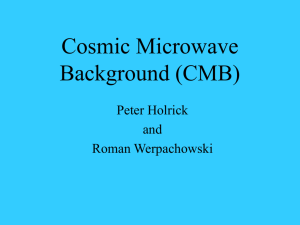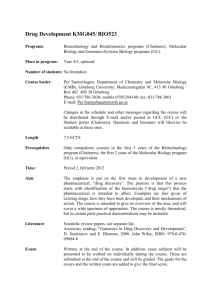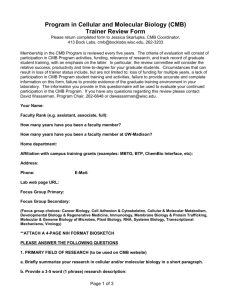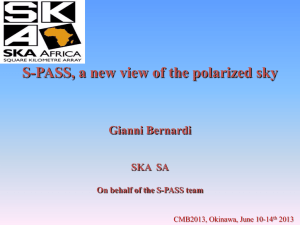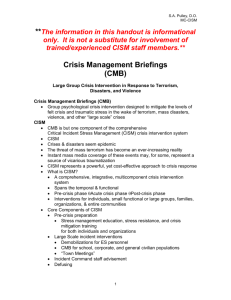宇宙学 - 中国科学院理论物理研究所
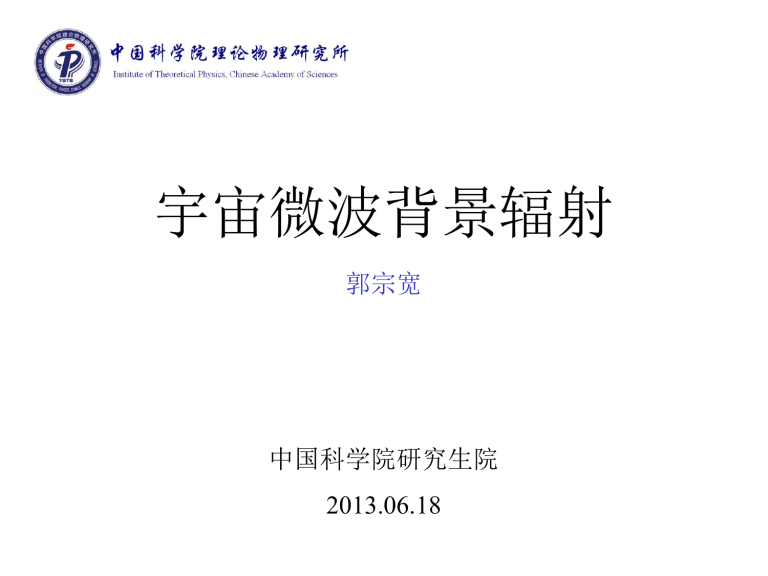
宇宙微波背景辐射
郭宗宽
中国科学院研究生院
2013.06.18
交叉学科:宇宙学
• 宇宙学基本假设和理论基础
宇宙学原理(无边,无中心)
爱因斯坦引力理论
宇宙物质(重子 + 光子 + 中微子 + 暗物质 + 暗能量 )
• 观测实验的重要性
3
个观测: 星系红移 , 原初核丰度 , 宇宙微波背景辐射
超新星,大尺度结构 (2dFGRS,SDSS,LSST) , 宇宙微波背景辐射 ,
宇宙射线 (Fermi-LAT,PAMELA,AMS-02) , 21 厘米谱线,射电波 (SKA) ,
弱引力透镜,引力波,中微子
• 目前的进展和存在的问题
宇宙加速膨胀(暴涨, 暗能量,修改引力,非均匀宇宙 )
宇宙大尺度结构形成(冷 / 温 / 热暗物质,暗物质粒子的性质,暗物质分布)
Adam G. Riess Saul Perlmutter Brian P. Schmidt
The Nobel Prize in Physics 2011 was divided, one half awarded to Saul Perlmutter (leader of SCP), the other half jointly to Brian
P. Schmidt (leader of High-Z) and Adam G. Riess (High-Z) "for the discovery of the accelerating expansion of the Universe through observations of distant supernovae".
A.G. Riess et al ., Astron. J. 116 (1998) 1009 [arXiv:astro-ph/ 9805201 ]
S. Perlmutter et al ., Astrophys. J. 517 (1999) 565 [arXiv:astro-ph/ 9812133 ]
内容
1.
宇宙微波背景(
CMB
)辐射的形成
2.
CMB
的发现和探测实验
3.
CMB
的数据分析
4.
CMB
各向异性的物理起源
5.
CMB
的宇宙学解释
6.
现状与展望
1. CMB 的形成 p
e
H
the reaction rate vs. the expansion rate decoupling during recombination
2. CMB 的发现和探测实验
The CMB was first predicted by G. Gamow, R. Alpher and
R. Herman in 1948
T~5 K
the first discovery of the CMB radiation in 1964-1965 the Nobel
Prize in Physics 1978:
A.A. Penzias and R.W. Wilson
It is interpreted by R. Wilson, B. Burke, R. Dicke and J. Peebles in 1965.
COBE (Cosmic Background Explorer) - the first generation CMB experiment, launched on 18 Nov. 1989, 4 years the Nobel Prize in Physics 2006: J.C. Mather and G.F. Smoot
Hot big bang
J.C. Mather G.F. Smoot (DMR) isotropy
the COBE satellite experiments:
① the Far InfraRed Absolute
Spectrophotometer (FIRAS) team
② the Differential Microwave
Radiometer (DMR) team
advantages of satellite experiments:
• no atmospheric thermal emission
• full-sky map
WMAP (Wilkinson Microwave Anisotropy Probe) - the second generation CMB experiment, launched on 30 June 2001, 9 years
141 °
23 GHz
33 GHz
41 GHz
61 GHz
• free-free emission : electron-ion scattering
• synchrotron emission : the acceleration of cosmic ray electrons in magnetic fields
• thermal emission from dust
94 GHz
• foreground mask • angular power spectrum of CMB
• WMAP science team publications a) 2003, WMAP1, 14 papers, cited by 6873 records b) 2007, WMAP3, 5 papers, cited by 5289 records c) 2009, WMAP5, 8 papers, cited by 3527 records d) 2011, WMAP7, 6 papers, cited by 3803 records e) 2012, WMAP9, 2 papers, cited by 303 records
We have entered a new era of precision cosmology.
Planck - the third generation CMB experiment, launched on 14 May 2009, 30 months, 5 full-sky surveys
LFI : 30,44,70 GHz
HFI : 100,143,217,353,545,857 GHz
• high sensitivity
• wide frequency
• full-sky coverage
• high resolution ~7º,15′,5′
the temperature angular power spectrum cosmological parameters
20 March 2013,
29 papers
next generation space-based CMB experiment
•
NASA: CMBPol
•
ESA: COrE
Other experiments
• ground-based experiments
ACBAR, BICEP, CBI, VSA, QUaD, BICEP2, …
ACT , ACTPol from 2013
SPT , SPTpol from 2012
QUBIC (r~0.01,bolometer, interferometer)
• balloon-borne experiments
BOOMRANG, MAXIMA, …
EBEX
Spider
South Pole Telescope (SPT)
10 meter telescope
3 frequencies (95, 150 and 220 GHz) arXiv:1105.3182: SPT+WMAP7+BAO+H0
𝑁eff = 3.86 ± 0.42
arXiv:1212.6267: SPT+WMAP7+BAO+H0
∑𝑚 𝜈
= 0.32 ± 0.11 eV
Atacama Cosmology Telescope (ACT)
3 frequencies ( 148 , 218, and 277 GHz)
6 meter telescope
3. CMB 的数据分析 time-ordered data full sky map
time-ordered data spectrum parameter estimates d t
P ti m i
n t
the temperature anisotropies can be expanded in spherical harmonics
T a lm
(
,
)
T
d
lm a
T (
lm
Y
,
) lm
Y
T
*
(
,
) lm
(
,
)
for Gaussian random fluctuations, the statistical properties of the temperature field are determined by the angular power spectrum a lm a l
*
' m '
C l
T
ll '
mm '
For a full sky, noiseless experiments,
C l
T
2 l
1
1 m l
l a lm
2
cosmological parameter estimation likelihood function for a full sky : the sky-cut, MCMC
4. CMB 各向异性的物理起源
• primary CMB anisotropies ( at recombination)
① inflation model (Alan H. Guth in 1981)
② primordial power spectrum of perturbations
③ angular power spectrum of CMB anisotropies
• secondary CMB anisotropies ( after recombination)
① thermal/kinetic Sunyaev-Zel’dovich effect
② integrated Sachs-Wolf effect
③ reionization
④ weak lensing effect
inflation model
V (
φ
) reheating inflation
φ for slow-roll inflation, the primordial power spectra of scalar/tensor perturbations:
the coupled, linearized Boltzmann, Einstein and fluid equations 𝑛, 𝜏 = 𝑓
0
(𝑞) 1 + Ψ ( 𝑛, 𝜏) 𝑓
0 𝑞 = 𝑔 𝑠
1 ℎ 3 𝑒 𝜖(𝑞)/𝑘
𝐵
𝑇∓1
∆𝑇
𝑇
= − 𝑑 ln 𝑓
0 𝑑 ln 𝑞
−1
Ψ
ℎ the metric in the synchronous gauge 𝑖𝑗 𝑑𝑠 2 = 𝑎 2 𝜏 [−𝑑𝜏 2 + (𝛿 𝑖𝑗
+ ℎ 𝑖𝑗
)𝑑𝑥 𝑖 𝑑𝑥 𝑗 ] ℎ 𝑖𝑗
3 𝑘𝑒
=
1
3 ℎ𝛿 𝑖𝑗
+ ℎ 𝑖𝑗
∥
+ ℎ 𝑖𝑗
⊥
+ ℎ 𝑖𝑗
𝑇 𝑘 𝑖 𝑘 𝑗 𝑘 𝑖 𝑘 𝑗
−
1
3 𝛿 𝑖𝑗
6𝜂(𝑘, 𝜏)] the Einstein equations
ℋ 2 =
8𝜋
𝐺𝑎 2
3 𝜌 𝑖 𝑖
, ℋ = −
4𝜋
3
𝐺𝑎 2 (𝜌 𝑖
+3𝑃 𝑖
) 𝑖 the equations of state 𝜔 𝑖
= 𝑃 𝑖
/𝜌 𝑖
the linearized Einstein equations in k -space 𝑘 2 𝜂 −
1
2
ℋ = −4𝜋𝐺𝑎 2 𝛿𝜌 𝑖 𝑖 𝑘 2 𝜂 = 4𝜋𝐺𝑎 2 (𝜌 𝑖
+ 𝑃 𝑖
) 𝜃 𝑖 𝑖
ℎ + 2ℋ ℎ − 2𝑘 2 𝜂 = −24𝜋𝐺𝑎 2 𝛿𝑃 𝑖 𝑖
ℎ + 6 𝜂 + 2ℋ( ℎ + 6 𝜂) − 2𝑘 2 𝜂 = −24𝜋𝐺𝑎 2 (𝜌 𝑖
+ 𝑃 𝑖
) 𝜎 𝑖 𝑖 the perturbed part of energy-momentum conservation equations for the non-relativistic fluid ( baryon, CDM, DE ) in k -space 𝛿 𝑖
= − 1 + 𝜔 𝑖 𝑖
𝜃 = −ℋ 1 − 3𝜔 𝑖 𝜃 𝑖
+
2
ℎ
− 3ℋ 𝛿𝑃 𝛿𝜌
− 𝜔 𝑖 𝛿 𝑖 𝜃 𝑖
− 𝜔 𝑖
1 + 𝜔 𝑖 𝜃 𝑖
+ 𝛿𝑃/𝛿𝜌
1 + 𝜔 𝑖 𝑘 2 𝛿 − 𝑘 2 𝜎 𝑖
the Boltzmann equation in the synchronous gauge for the photon and neutrino components in k -space
𝜕Ψ
𝜕𝜏
+ 𝑖 𝑞 𝜖 𝑘 ∙ Ψ + 𝑑 ln 𝑓 𝑑 ln 𝑞
0
𝜂 −
ℎ + 6 𝜂
( 𝑘 ∙ ) 2
2
=
1 𝑓
0
𝜕𝑓
𝜕𝜏
𝐶 for massless particles
𝑞
2 𝑑𝑞𝑞𝑓
0
(𝑞)Ψ
𝑞 2 𝑑𝑞𝑞𝑓
0
F is expanded in a Legendre series
∞
−𝑖 𝑙 2𝑙 + 1 𝐹 𝑙
( 𝑘 , 𝜏)𝑃 𝑙
( 𝑛 ) 𝑙=0 using 𝑃
0 𝜇 = 1 , 𝑃
1 𝜇 = 𝜇 , 𝑃
2 𝜇 = (3𝜇 2 − 1)/2 , the recursion relation and the orthonormality of the Legendre polynomials we obtain a hierarchy.
initial conditions for the CMB photon
∆𝑇
= −
𝑇 𝑑 ln 𝑓
0 𝑑 ln 𝑞
−1
Ψ =
𝐹 𝛾
4
3 𝑘𝑒
∞
−𝑖 𝑙 2𝑙 + 1 ∆ 𝑙
(𝑘, 𝜏)𝑃 𝑙 𝑙=0 initial conditions (radiation-dominated, outside the horizon, adiabatic mode, isocurvature mode)
∆ 𝑙 𝑘, 𝜏 = 𝜓(𝑘) ∆ 𝑙 𝑘, 𝜏 𝜓(𝑘
1
)𝜓(𝑘
2
) = 𝒫 𝑘 𝛿(𝑘
1
+ 𝑘
1
)
CMB anisotropy expanded in spherical harmonics 𝑥
0 𝑛, 𝜏
0
= 𝑑 3 𝑘𝑒 𝑥
0 𝑛, 𝜏
0 𝑛, 𝜏
0
= 𝑎 𝑙𝑚
(𝑘, 𝜏
0
)𝑌 𝑙𝑚 𝑙,𝑚 𝑎 𝑙𝑚 𝑘, 𝜏
0 𝑛, 𝜏
0
𝑌 𝑙𝑚 𝑛 = 4𝜋∆ 𝑙
(𝑘, 𝜏
0
)𝑌 𝑙𝑚 𝑘 the angular two-point correlation function 𝑥
0 𝑛
1
, 𝜏
0 𝑥
0 𝑛
2
, 𝜏
0
) =
∞
1
4𝜋
(2𝑙 + 1)𝐶 𝑙
𝑃 𝑙 𝑙=0 the angular power spectrum is 𝑛
1
𝐶 𝑙
= 4𝜋 𝑑𝑘 𝑘
𝒫 𝑘 |∆ 𝑙
(𝑘, 𝜏
0
)| 2 𝑛
2
)
features of spectrum
• large angular scales integrated SZ effect (<10)
Sachs-Wolf effect (10~100)
• intermediate scales acoustic oscillations (100~1000)
• small scales (>1000)
Silk damping: the dissipation of small-scale perturbations caused by photons' random walking out of overdense regions.
For full accuracy, the Boltzmann equation must be solved to follow the evolution of the photon distribution function.
5. CMB 的宇宙学解释
The stronger the contraction, the higher these peaks should be.
6. 现状与展望
Planck may be the
last
space-based experiment to measure the temperature spectrum.
no evidence for non-Gaussianity;
strong
constraints on non-Gaussianity
t
ension
between Planck and astrophysical measurements
a
nomalies
in the WMAP/Planck data (the quadrupole-octopole alignment, hemispherical asymmetry, the cold spot, …)
detection of the primordial
tensor
perturbations
